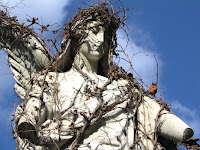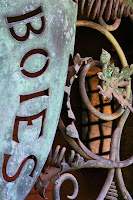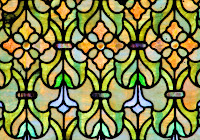Its six a.m. and raining outside. I’m nursing a head cold. Still, I’m thanking the Lord for yet another day above ground. It is Thanksgiving Day, as it happens. Rainy, bleak mornings like this make me think of abandoned graveyards, and how the cold and dismal rain beats down on the old stones. It can be a pitiful sight.
 Prior to my cemetery travels, I don’t remember even being aware of the existence of an “abandoned cemetery.” Surely, when I bring up the subject at parties, people look at me funny. You’d be surprised how many folks are unfamiliar with the concept. They might ask, “How do cemeteries become 'abandoned?'" Well, that’s the topic for today, friends. How do they become abandoned? And what happens to them after they attain this substandard status?
Prior to my cemetery travels, I don’t remember even being aware of the existence of an “abandoned cemetery.” Surely, when I bring up the subject at parties, people look at me funny. You’d be surprised how many folks are unfamiliar with the concept. They might ask, “How do cemeteries become 'abandoned?'" Well, that’s the topic for today, friends. How do they become abandoned? And what happens to them after they attain this substandard status?  |
| Mount Vernon Cemetery, Philadelphia |
 |
| Resurfaced Texas Cemetery |
There are probably hundreds of reasons why cemeteries get abandoned − I’ve only run into a few of them. Religious sect cemeteries that are left standing and unattended after the congregation is disbanded (a la B'nai Israel Cemetery in West Philly). Private little family plots on the old homestead (I’ve seen these in Virginia), where the homestead had long ago been divvied up and sold off as small land parcels leaving the little graveyard in the woods. Or the farmer’s field where they’ve plowed around an island of headstones for as long as anyone can recall. Facebook friends tell me these exist all over the country. In some states, you have legal right to cross private property to visit a cemetery that has no public access!
 |
| Philadelphia's Mt. Moriah Cemetery |
 Sometimes I think we have the same false notions about cemeteries as we have about Thanksgiving (which had nothing to do with turkey and pumpkin pie, or giving thanks, for that matter). Thanksgiving Day was a single event in 1621, one day when politics brought pilgrims and Indians together. Tension and posturing by each group was evident as Pilgrims and Indian tribes attempted to ensure their own survival. What has come to be accepted as a harvest celebration or day of thanks wasn’t even referred to as “Thanksgiving” day until 1841. Thanksgiving as we know it did not become a national holiday until 1863, when Abraham Lincoln could no longer take the relentless badgering by Godey’s Lady’s Book editor Sarah Josepha Hale. He conceded that it might help national unification after the Civil War. Needless to say, the idea of a New England-originated Thanksgiving Day Holiday was not embraced by Southern states.
Sometimes I think we have the same false notions about cemeteries as we have about Thanksgiving (which had nothing to do with turkey and pumpkin pie, or giving thanks, for that matter). Thanksgiving Day was a single event in 1621, one day when politics brought pilgrims and Indians together. Tension and posturing by each group was evident as Pilgrims and Indian tribes attempted to ensure their own survival. What has come to be accepted as a harvest celebration or day of thanks wasn’t even referred to as “Thanksgiving” day until 1841. Thanksgiving as we know it did not become a national holiday until 1863, when Abraham Lincoln could no longer take the relentless badgering by Godey’s Lady’s Book editor Sarah Josepha Hale. He conceded that it might help national unification after the Civil War. Needless to say, the idea of a New England-originated Thanksgiving Day Holiday was not embraced by Southern states.But I seem to be getting off track here. I apologize. My narrative may become more linear as the effects of whatever medication I ingested last night wears off. The Native American community calls our Thanksgiving Day their “National Day of Mourning,” the day they mourn the genocide of their ancestors and the theft of their land. This largely fabricated holiday of ours is a prime example of history re-written to make us feel better about ourselves. Kind of reminds me of the following story.
 |
| Franklin Cemetery, c. 1940 |
"I'm telling you, in this day and age,The dead people aren't even safe.. . . Everyone's out for that almighty dollar.Now only if the dead could holler."
What can happen after a cemetery is abandoned is that it can get condemned and then obliterated, if the land has any value. The bodies are (theoretically) moved and the land is repurposed. That’s the case with the photo at the beginning of this article. It may seem shocking, and it is. In 1922, Philadelphia condemned the Hanover Street Burial Ground, and left it up to relatives of the deceased to remove the bodies!
The Business of Running a Cemetery
Unless a non-profit group is responsible for it, a cemetery is run as a business. As such, it is susceptible to all the financial problems any business might experience – a bad year, a drop in popularity, embezzlement of funds by the owners or other financial mismanagement, and of course, over time, it can become filled up, so no more burials are possible!
 |
| Discarded tombstones along Delaware River |
Though they seem to be in the limelight right now (with many neighborhood efforts to clean them up and restore them), abandoned graveyards are not a modern issue, a contemporary conundrum. The Hanover photo at top was taken around 1922! By then, the Hanover Street Burial Ground in Philadelphia’s Fish town neighborhood had long been abandoned (it was about 117 years old). (My thanks to Ken Milano for allowing me to use the image from his superb book, Palmer Cemetery and the Historic Burial Grounds of Kensington and Fishtown). Capitola Playground in South Philly and Johnson Cemetery Park (I swear this is really what it’s called, see blog) in Camden Jew Jersey were both originally forgotten cemeteries landscaped over to become neighborhood parks.
Some forsaken cemeteries reside on land that is worthless to real estate developers. These are the ones that languish, and may never get revitalized by any charitable organization. Small ones seem forlorn and pitiful, larger ones can be frightening, like sleeping monsters. The detritus of a civilization, one that doesn’t seem to attach much value to its own history.
 As I watch a scavenger outside my kitchen window pick through my trash, I’m taken by its parallel to my interest in abandoned cemeteries. I feel like I’m picking through things other people no longer want. Looking for something that interests me, never really knowing what I might find. The more we educate ourselves about cemeteries, the more can we learn about ourselves – information is preservation. Preserving memory is supposed to be what cemeteries are all about, isn’t it? Well, maybe there are some things we’d just rather not be reminded of.
As I watch a scavenger outside my kitchen window pick through my trash, I’m taken by its parallel to my interest in abandoned cemeteries. I feel like I’m picking through things other people no longer want. Looking for something that interests me, never really knowing what I might find. The more we educate ourselves about cemeteries, the more can we learn about ourselves – information is preservation. Preserving memory is supposed to be what cemeteries are all about, isn’t it? Well, maybe there are some things we’d just rather not be reminded of. References and Further Reading:
Ed Snyder has written many Cemetery Traveler blogs about abandoned cemeteries. Here are a few:
New Jersey: Abandoned Cemetery...or just Repurposed?
New Jersey: Abandoned Cemetery...or just Repurposed?
Twain’s Feast – Searching for America’s Lost Foods, by Andrew Beahrs
Rest in Pieces: Philadelphia's Lost Cemeteries (Tom Keels)
Philadelphia Graveyards and Cemeteries by Tom Keels
Philadelphia Graveyards and Cemeteries by Tom Keels































